Critical Factors Influencing Viability of Wave Energy Converters in Off-Grid Luxury Resorts and Small Utilities
Abstract
:1. Introduction
1.1. Problem Description
1.2. Status of the Industry
1.3. Purpose of Research
2. Theoretical Framework and Research Methods
2.1. Wave Energy Converter Farm System
2.2. Theoretical Framework
2.2.1. Levelized Cost of Energy
2.2.2. PESTEL
2.2.3. Porter’s 5 Forces (P5F)
2.3. Research Methodology and the Viability Model
3. Results and Discussion
3.1. Discussion of Factors Affecting Viability of Off-Grid WEC Systems
3.1.1. LCOE
3.1.2. PESTEL
3.1.3. P5F
3.2. Case Discussion
3.2.1. LCOE
3.2.2. P5F
3.2.3. PESTEL
3.2.4. Cases
4. Conclusions
Acknowledgments
Author Contributions
Conflicts of Interest
References
- The International Renewable Energy Agency (IRENA). Wave Energy Technology Brief. 2014. Available online: http://www.irena.org/documentdownloads/publications/wave-energy_v4_web.pdf (accessed on 1 April 2016).
- Chozas, J.F. Technical and Non-Technical Issues towards the Commercialisation of Wave Energy Converters; River Publishers: Aalborg Ø, Denmark, 2013. [Google Scholar]
- Dalton, G. Non-Technical Barriers to Wave Energy in Europe; Input to the Waveplam Project; University College Cork, HMRC: Cork, Ireland, 2009. [Google Scholar]
- Edenhofer, O.; Pichs-Madruga, R.; Sokona, Y. Renewable Energy Sources and Climate Change Mitigation: Special Report of the Intergovernmental Panel on Climate Change; Cambridge University Press: Cambridge, UK, 2011. [Google Scholar]
- Callaghan, J.; Boud, R. Future Marine Energy: Results of the Marine Energy Challenge: Cost Competitiveness and Growth of Wave and Tidal Stream Energy; Carbon Trust: London, UK, 2006. [Google Scholar]
- International Energy Agency (IEA). Key World Energy Statistics 2015. 2015. Available online: https://www.iea.org/publications/freepublications/publication/key-world-energy-statistics-2015.html (accessed on 22 March 2016).
- Magagna, D.; Uihlein, A. 2014 JRC Ocean Energy Status Report. 2014, p. 74. Available online: https://setis.ec.europa.eu/sites/default/files/reports/2014-JRC-Ocean-Energy-Status-Report.pdf (accessed on 12 February 2016).
- Nilsson, H. Off-Grid Market Opportunities for Wave Power Technology. Master’s Thesis, Department of Production Management, Lund University, Lund, Sweden, January 2016. [Google Scholar]
- Peterson, T. Multi Market Business Development Research; Marshfield Hills: Marshfield, MA, USA, 2016. [Google Scholar]
- Branker, K.; Pathak, M.; Pearce, J.M. A review of solar photovoltaic levelized cost of electricity. Renew. Sustain. Energy Rev. 2011, 15, 4470–4482. [Google Scholar] [CrossRef]
- De Andres, A.; Maillet, J.; Todalshaug, J.H.; Möller, P.; Bould, D.; Jeffrey, H. Techno-Economic Related Metrics for a Wave Energy Converters Feasibility Assessment. Sustainability 2016, 8, 1109. [Google Scholar] [CrossRef]
- Boussabaine, A.; Kirkham, R. Whole Life-Cycle Costing: Risk and Risk Responses; John Wiley & Sons: New York, NY, USA, 2008. [Google Scholar]
- Gupta, A. Environmental and pest analysis: An approach to external business environment. Merit Res. J. Art Soc. Sci. Hum. 2013, 1, 13–17. [Google Scholar]
- Wüstenhagen, R.; Wolsink, M.; Bürer, M.J. Social acceptance of renewable energy innovation: An introduction to the concept. Energy Policy 2007, 35, 2683–2691. [Google Scholar] [CrossRef]
- Porter, M.E. How Competitive Forces Shape Strategy. Harv. Bus. Rev. 1979, 57, 137–145. [Google Scholar]
- Woodside, A.G. Case Study Research: Theory, Methods and Practice: Theory, Methods, Practice; Emerald Group Publishing: Bingley, UK, 2010. [Google Scholar]
- Yin, R. Case Study Research: Design and Methods; Sage Publishing: Beverly Hills, CA, USA, 1994. [Google Scholar]
- Frazerhurst, J. Determination of Optimum Wave Power Sites in New Zealand by Analysis of the Coastline, Continental Shelf and Wave Climate; Wavegen, ASR: Inverness, UK, 2006. [Google Scholar]
- Dalton, G.; Allan, G.; Beaumont, N.; Georgakaki, A.; Hacking, N.; Hooper, T.; Kerr, S.; O’Hagan, A.M.; Reilly, K.; Ricci, P.; et al. Economic and socio-economic assessment methods for ocean renewable energy: Public and private perspectives. Renew. Sustain. Energy Rev. 2015, 45, 850–878. [Google Scholar] [CrossRef]
- Gonçalves, M.; Martinho, P.; Soares, C.G. Assessment of wave energy in the Canary Islands. Renew. Energy 2014, 68, 774–784. [Google Scholar] [CrossRef]
- Iglesias, G.; Carballo, R. Choosing the site for the first wave farm in a region: A case study in the Galician Southwest (Spain). Energy 2011, 36, 5525–5531. [Google Scholar] [CrossRef]
- Khan, J.; Bhuyan, G.; Moshref, A. Potential Opportunities and Differences Associated with Integration of Ocean Wave and Marine Current Energy Plants in Comparison to Wind Energy; Final Annex III Technical Report—2009-IEA-OES Document; Ocean Energy Systems: Lisbon, Portugal, 2009; p. 64. [Google Scholar]
- Passey, R.; Spooner, T.; MacGill, I.; Watt, M.; Syngellakis, K. The potential impacts of grid-connected distributed generation and how to address them: A review of technical and non-technical factors. Energy Policy 2011, 39, 6280–6290. [Google Scholar] [CrossRef]
- Hafemeister, D.; Kammen, D.; Levi, B.G.; Schwartz, P. Physics of Sustainable Energy II: Using Energy Efficiently and Producing It Renewably. In Proceedings of the American Institute of Physics Conference Series, Berkeley, CA, USA, 5–8 March 2011.
- International Electrotechnical Commission (IEC). Grid Integration of Large-Capacity Renewable Energy Sources and Use of Large-Capacity Electrical Energy Storage; White Paper; International Electrotechnical Commission: Geneva, Switzerland, 2012. [Google Scholar]
- The International Renewable Energy Agency (IRENA). Battery Storage for Renewables: Market Status and Technology Outlook. 2015. Available online: http://www.irena.org/menu/index.aspx?mnu=Subcat&PriMenuID=36&CatID=141&SubcatID=495 (accessed on 13 March 2016).
- Weitemeyer, S.; Kleinhans, D.; Vogt, T.; Agert, C. Integration of Renewable Energy Sources in future power systems: The role of storage. Renew. Energy 2015, 75, 14–20. [Google Scholar] [CrossRef]
- Sharkey, F.; Bannon, E.; Conlon, M.; Gaughan, K. Maximising value of electrical networks for wave energy converter arrays. Int. J. Mar. Energy 2013, 1, 55–69. [Google Scholar] [CrossRef]
- Dalton, G.; Lewis, T.; O’Connor, M. Impact of inter-annual resource data variability on techno-economic performance of the WaveStar and Pelamis P1. In Proceedings of the 2012 4th International Conference of Ocean Energy, Dublin, Ireland, 17–19 October 2012.
- O’Connor, M.; Lewis, T.; Dalton, G. Operational expenditure costs for wave energy projects and impacts on financial returns. Renew. Energy 2013, 50, 1119–1131. [Google Scholar] [CrossRef]
- Guanche, R.; de Andrés, A.D.; Simal, P.D.; Vidal, C.; Losada, I.J. Uncertainty analysis of wave energy farms financial indicators. Renew. Energy 2014, 68, 570–580. [Google Scholar] [CrossRef]
- Dalton, G.; Lockington, D.; Baldock, T. A survey of tourist attitudes to renewable energy supply in Australian hotel accommodation. Renew. Energy 2008, 33, 2174–2185. [Google Scholar] [CrossRef]
- Bonar, P.A.; Bryden, I.G.; Borthwick, A.G. Social and ecological impacts of marine energy development. Renew. Sustain. Energy Rev. 2015, 47, 486–495. [Google Scholar] [CrossRef]
- Clément, A.; McCullen, P.; Falcão, A.; Fiorentino, A.; Gardner, F.; Hammarlund, K.; Lemonis, G.; Lewis, T.; Nielsen, K.; Petroncini, S.; et al. Wave energy in Europe: Current status and perspectives. Renew. Sustain. Energy Rev. 2002, 6, 405–431. [Google Scholar] [CrossRef]
- Stefanovich, M.; Chozas, J.F. Toward best practices for public acceptability in wave energy: Issues developers need to address. In Proceedings of the ICOE 2010 3rd International Conference on Ocean Energy, Bilbao, Spain, 6–8 October 2010.
- Leeney, R.H.; Greaves, D.; Conley, D.; O’Hagan, A.M. Environmental Impact Assessments for wave energy developments—Learning from existing activities and informing future research priorities. Ocean Coast. Manag. 2014, 99, 14–22. [Google Scholar] [CrossRef]
- Margheritini, L.; Hansen, A.M.; Frigaard, P. A method for EIA scoping of wave energy converters—Based on classification of the used technology. Environ. Impact Assess. Rev. 2012, 32, 33–44. [Google Scholar] [CrossRef]
- Azzellino, A.; Conley, D.; Vicinanza, D.; Kofoed, J.P. Marine renewable energies: Perspectives and implications for marine ecosystems. Sci. World J. 2013. [Google Scholar] [CrossRef] [PubMed]
- Bailey, I.; West, J.; Whitehead, I. Out of sight but not out of mind? Public perceptions of wave energy. J. Environ. Policy Plan. 2011, 13, 139–157. [Google Scholar] [CrossRef]
- The International Renewable Energy Agency (IRENA). Renewable Energy Integration in Power Grids. 2015. Available online: http://www.irena.org/DocumentDownloads/Publications/IRENA-ETSAP_Tech_Brief_Power_Grid_Integration_2015.pdf (accessed on 2 March 2016).
- Chozas, J.F.; Kofoed, J.P.; Sørensen, H.C. Predictability and Variability of Wave and Wind; Department of Civil Engineering, Aalborg University: Aalborg, Denmark, 2013. [Google Scholar]
- Sierra, J.; González-Marco, D.; Sospedra, J.; Gironella, X.; Mösso, C.; Sánchez-Arcilla, A. Wave energy resource assessment in Lanzarote (Spain). Renew. Energy 2013, 55, 480–489. [Google Scholar] [CrossRef]
- Ministry of Environment and Energy. Maldives SREP Investment Plan; Ministry of Environment and Energy: Athens, Greece, 2012. Available online: https://www-cif.climateinvestmentfunds.org/sites/default/files/meeting-documents/srep_5_maldives_0_0.pdf (accessed on 26 March 2016).
- Foo, M.C. From Fuel Based Electricity to Renewable Energy. 2012. Available online: http://www.pecc.org/resources/minerals-a-energy/1826-from-fuel-based-electricity-to-renewable-energy/file (accessed on 5 January 2016).
- Otto, S.D.; Bevacqua, M.; Ferràn, F. Energy (R)evolution for the Canary Islands. 2015. Available online: http://www.dlr.de/dlr/Portaldata/1/Resources/documents/2015/Energy_R_evolution_CanaryIslands_ExecutiveSummary_EN.pdf (accessed on 22 January 2016).
- Renvall, M. Norway’s Langlee Inks Wave Power Agreement with Spain’s Tenerife Island. 2014. Available online: http://www.nordicgreen.net/startups/article/norway-s-langlee-inks-wave-power-agreement-spain-s-tenerife-island (accessed on 17 March 2016).
- Blac, J.; Bitot, S. Schéma Directeur des Energies Renouvelables. Carbon 4. 2012. Available online: http://www.carbone4.com/download/polynesie/Schema_Directeur_Polynesie.pdf (acessed on 4 January 2016).
- Kench, P.S.; Brander, R.W.; Parnell, K.E.; McLean, R.F. Wave energy gradients across a Maldivian atoll: Implications for island geomorphology. Geomorphology 2006, 81, 1–17. [Google Scholar] [CrossRef]
- Naan, R. Why Energy Storage Is about to Get Big—And Cheap. Ramez Naan Energy Blog. 2015. Available online: http://rameznaam.com/2015/04/14/energy-storage-about-to-get-big-and-cheap/ (accessed on 1 December 2016).
- Myhr, A.; Bjerkseter, C.; Ågotnes, A.; Nygaard, T.A. Levelised cost of energy for offshore floating wind turbines in a life cycle perspective. Renew. Energy 2014, 66, 714–728. [Google Scholar] [CrossRef]
- Perraud, M. The Economic Challenge of Distributed Technologies for Insular Utilities. In Proceedings of the 2014 Pacific Power Association (PPA) Conference, Tahiti, French Polynesia, 10 July 2014; Available online: http://www.ppa.org.fj/wp-content/uploads/2014/07/1630-Blacktip-Consulting-Blistering-in-the-sun-v1-2-Final.pdf (accessed on 2 March 2016).
- The International Renewable Energy Agency (IRENA). Renewable Energy Opportunities for Island Tourism. 2014. Available online: http://www.irena.org/DocumentDownloads/Publications/IRENA_RE_Island_Tourism_report_2014.pdf (accessed on 13 March 2016).
- Hameed, S. Gili Lankanfushi Resort Goes Green with Floating Solar Panels. 2015. Available online: http://www.gili-lankanfushi.com/publication/a-solar-future-gili-lankanfushi-plugs-in-the-largest-floating-solar-panel-in-the-maldives/ (accessed on 19 February 2016).
- Karniouchina, E.V.; Carson, S.J.; Short, J.C.; Ketchen, D.J., Jr. Extending the firm vs. industry debate: Does industry life cycle stage matter? Strateg. Manag. J. 2013, 34, 1010–1018. [Google Scholar] [CrossRef]
- Schilke, O. On the contingent value of dynamic capabilities for competitive advantage: The nonlinear moderating effect of environmental dynamism. Strateg. Manag. J. 2014, 35, 179–203. [Google Scholar] [CrossRef]
- Zubair, S.; Bowen, D.; Elwin, J. Not quite paradise: Inadequacies of environmental impact assessment in the Maldives. Tour. Manag. 2011, 32, 225–234. [Google Scholar] [CrossRef]
- The International Renewable Energy Agency (IRENA). Renewable Energy Roadmap: The Republic of Maldives. 2015. Available online: http://www.irena.org/EventDocs/Maldives/Maldivesroadmapbackgroundreport.pdf (accessed on 1 March 2016).
- Malone, L. Political Instability Is Key Concern at Maldives Renewable Energy Investment Conference. 2013. Available online: http://minivannewsarchive.com/politics/participants-identify-political-instability-as-key-concern-at-maldives-renewable-energy-investment-conference-59697 (accessed on 6 April 2016).
- MacLellan, N. Down but Not Out in French Polynesia. 2014. Available online: http://pacificpolicy.org/2014/11/down-but-not-out-in-french-polynesia/ (accessed on 27 February 2016).
- Hourçourigaray, J.; Wary, D.; Bitot, S. Renewable Energy in the Pacific Islands: An Overview and Exemplary Projects. 2014. Available online: http://www.afd.fr/webdav/site/afd/shared/PUBLICATIONS/RECHERCHE/Scientifiques/Serie-grise/Energies-renouv-VA.pdf (accessed on 1 December 2016).
- Renewables International. Spanish Feed-in Tariffs—A Wrapup. 2013. Available online: http://www.renewablesinternational.net/spanish-feed-in-tariffs-a-wrapup/150/537/71424/ (accessed on 12 February 2016).
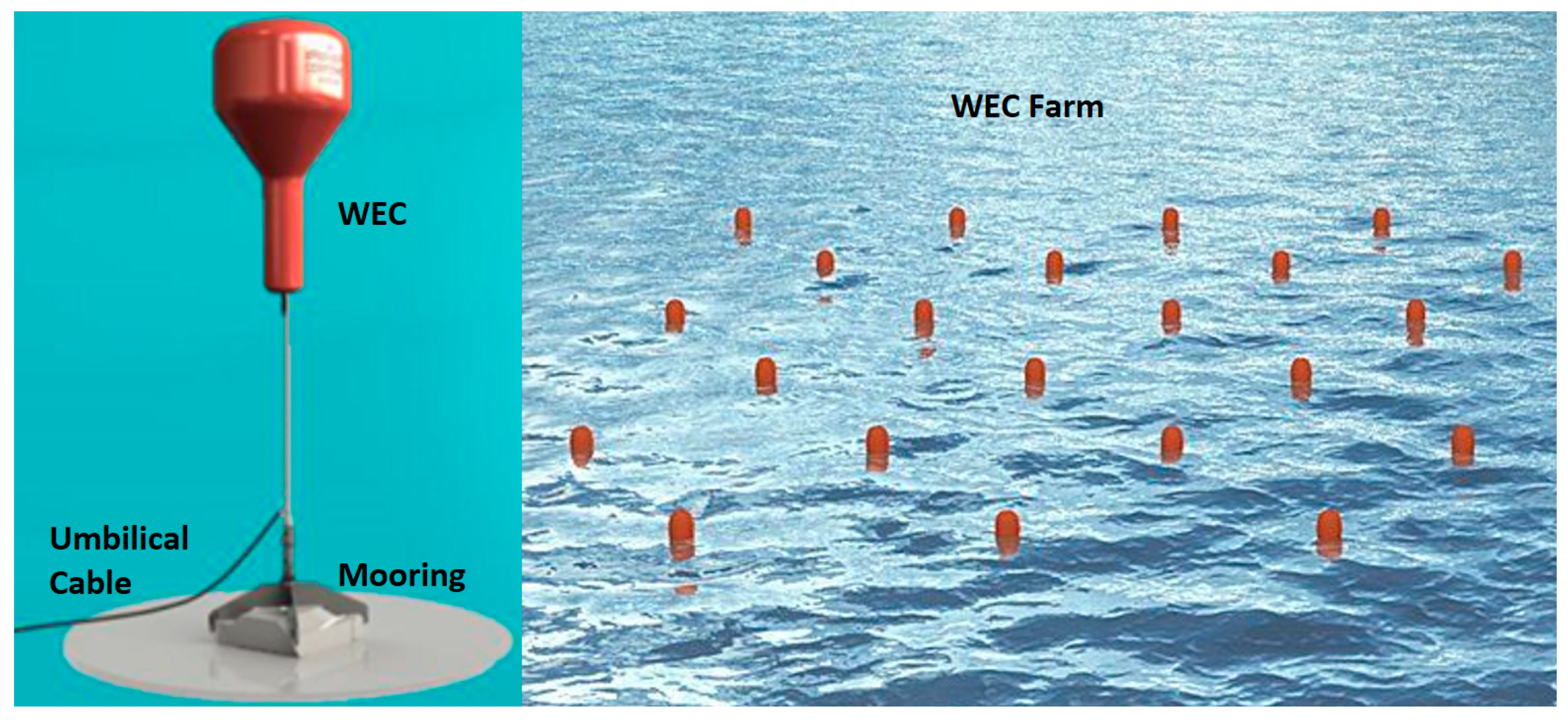
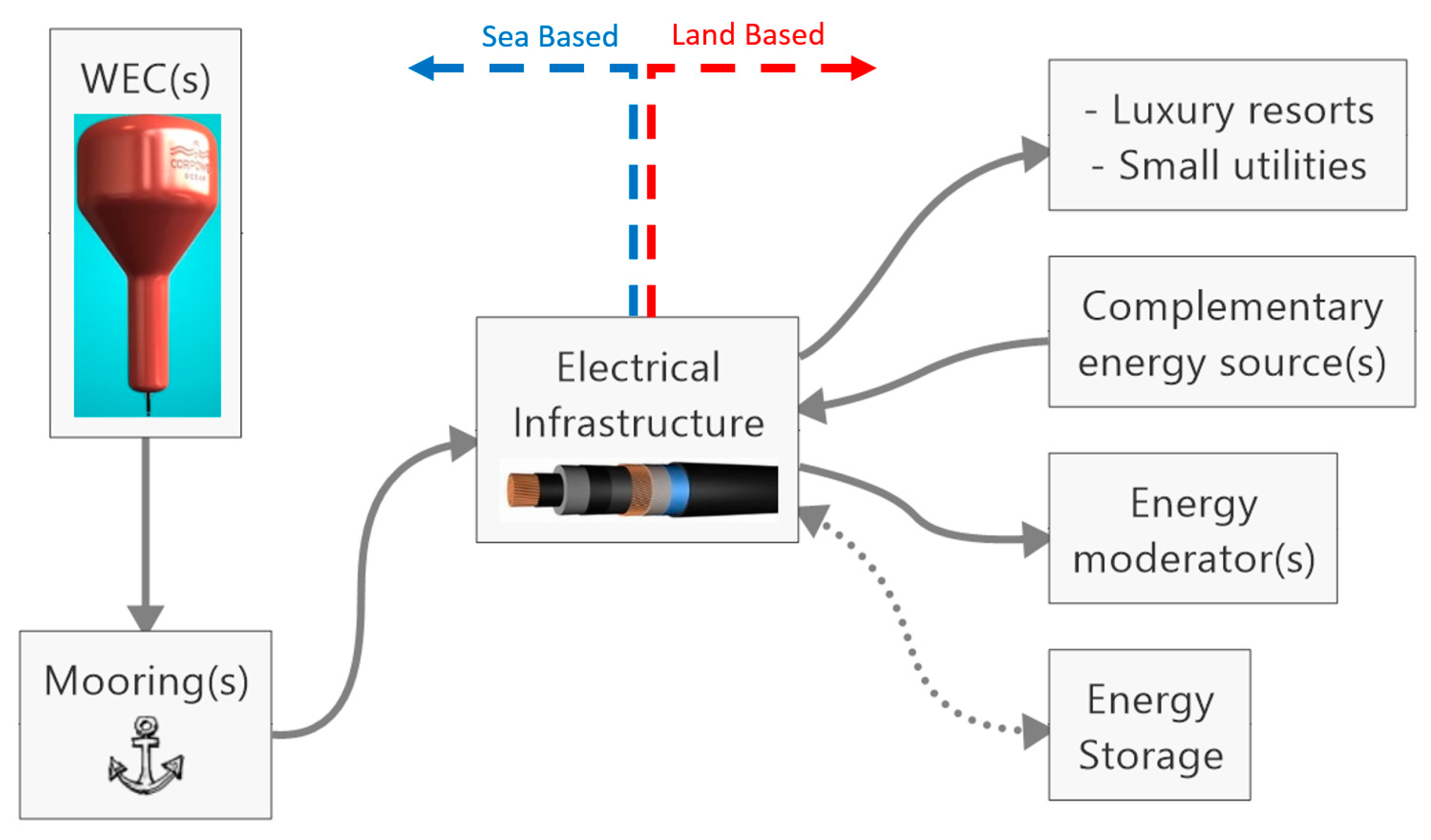
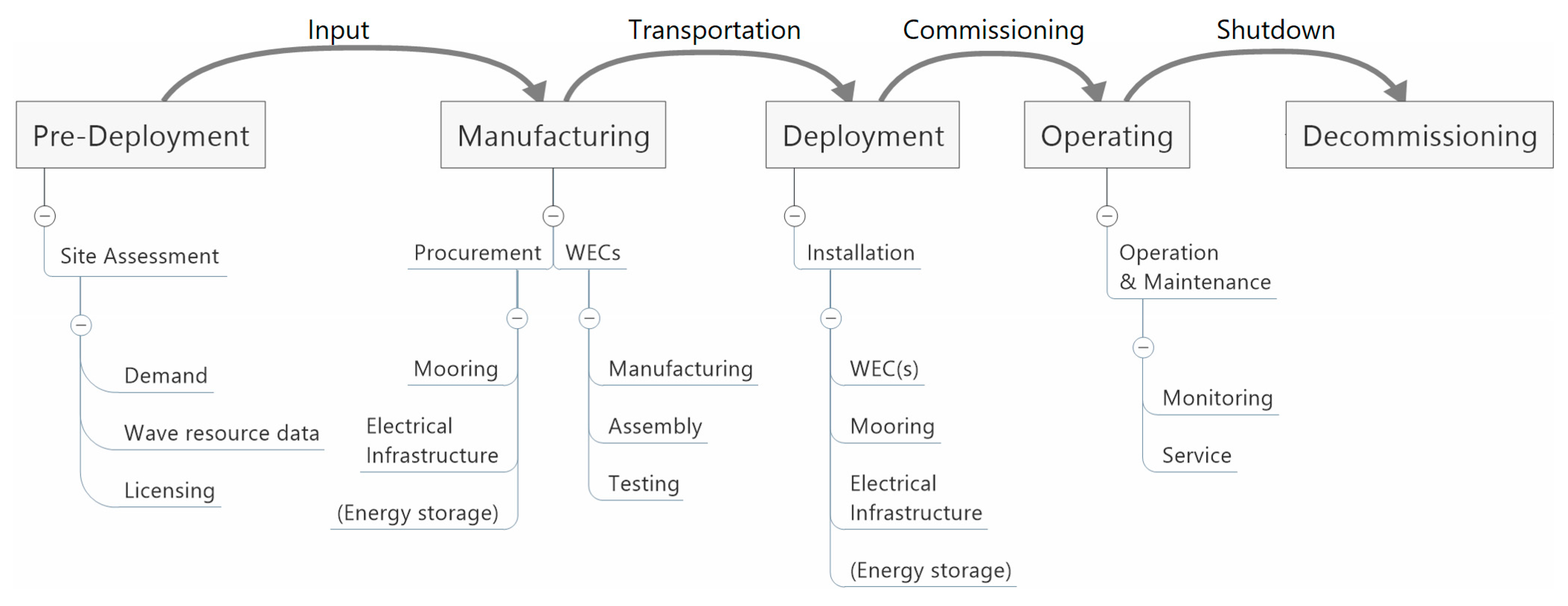
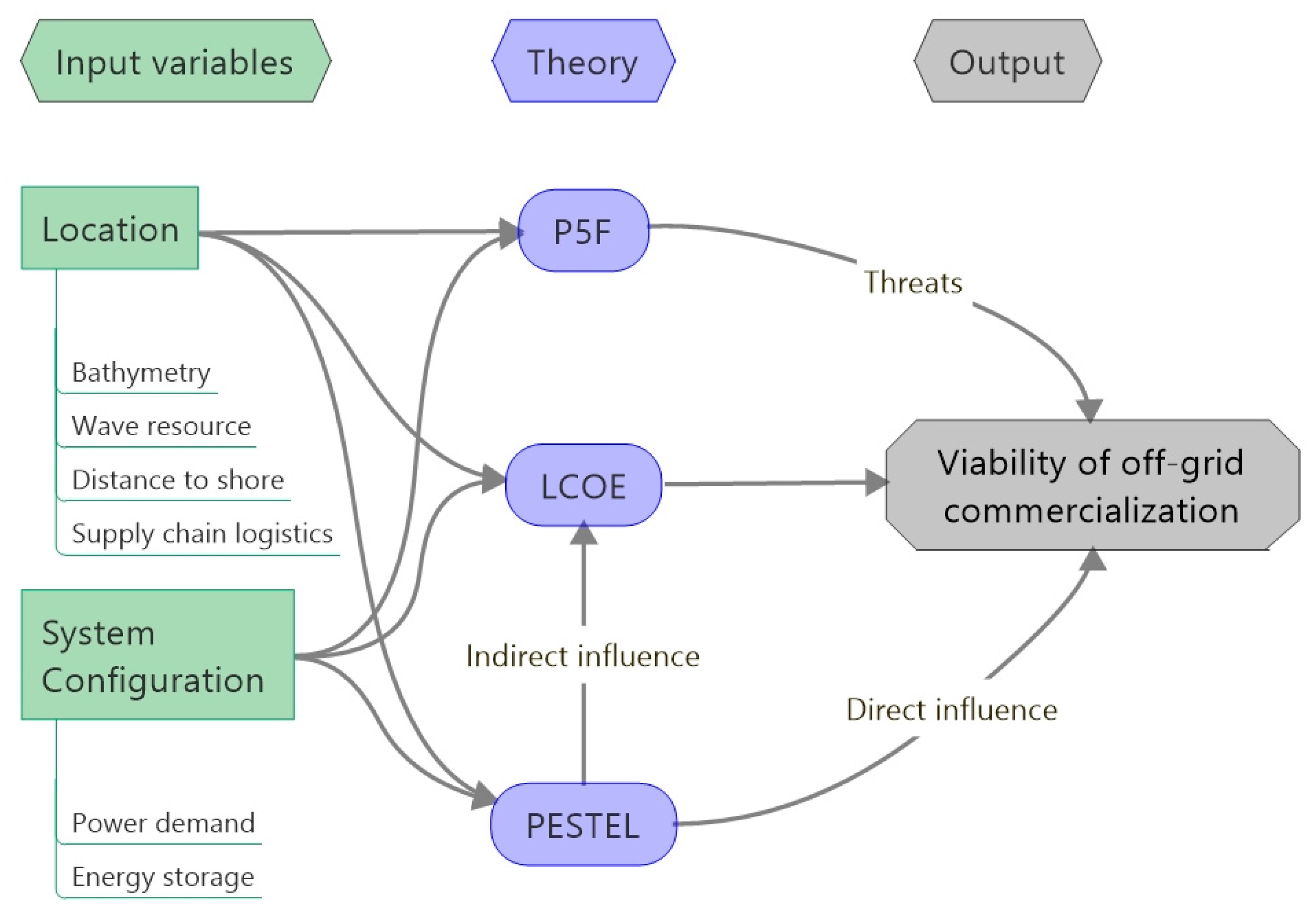

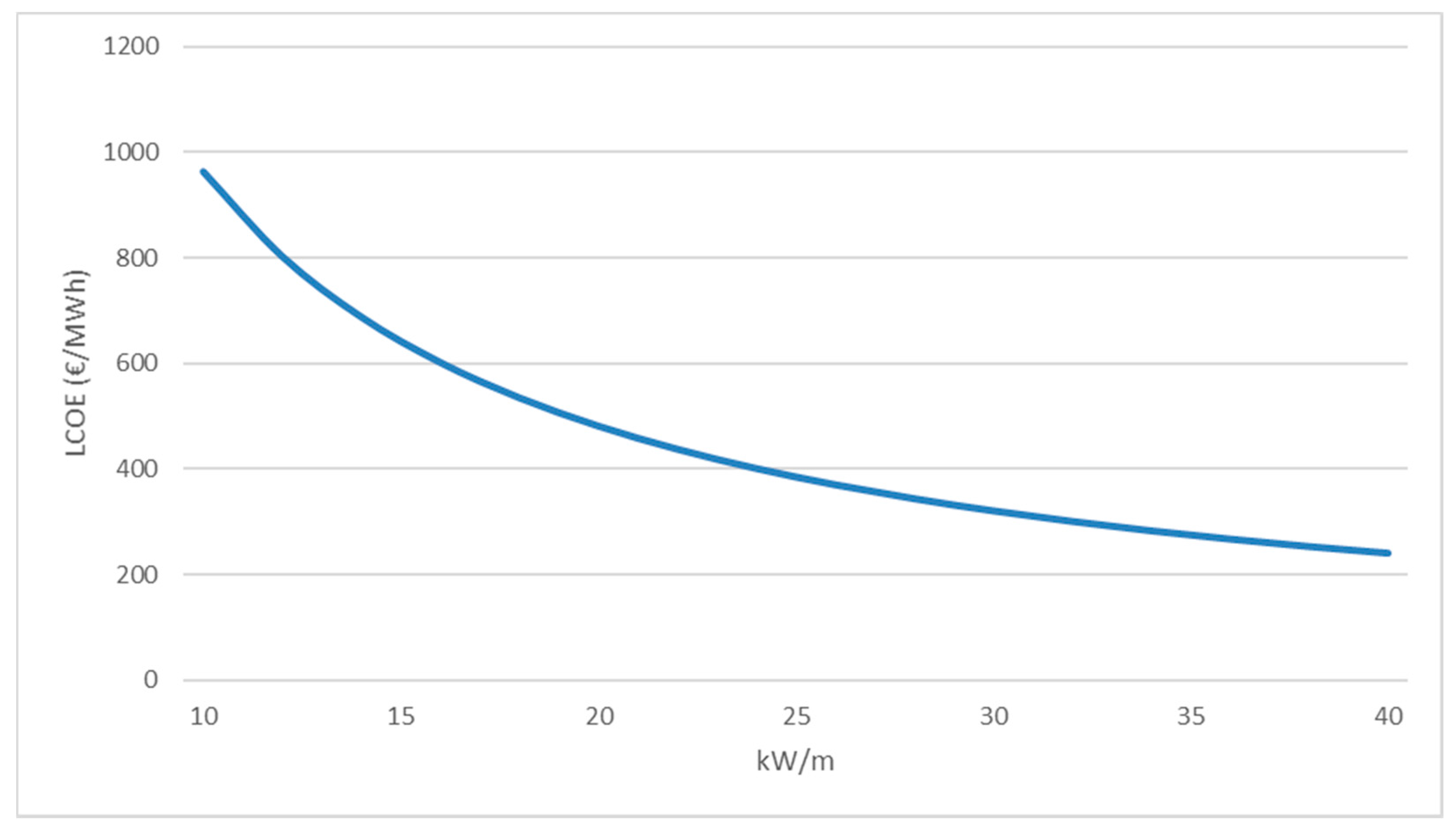
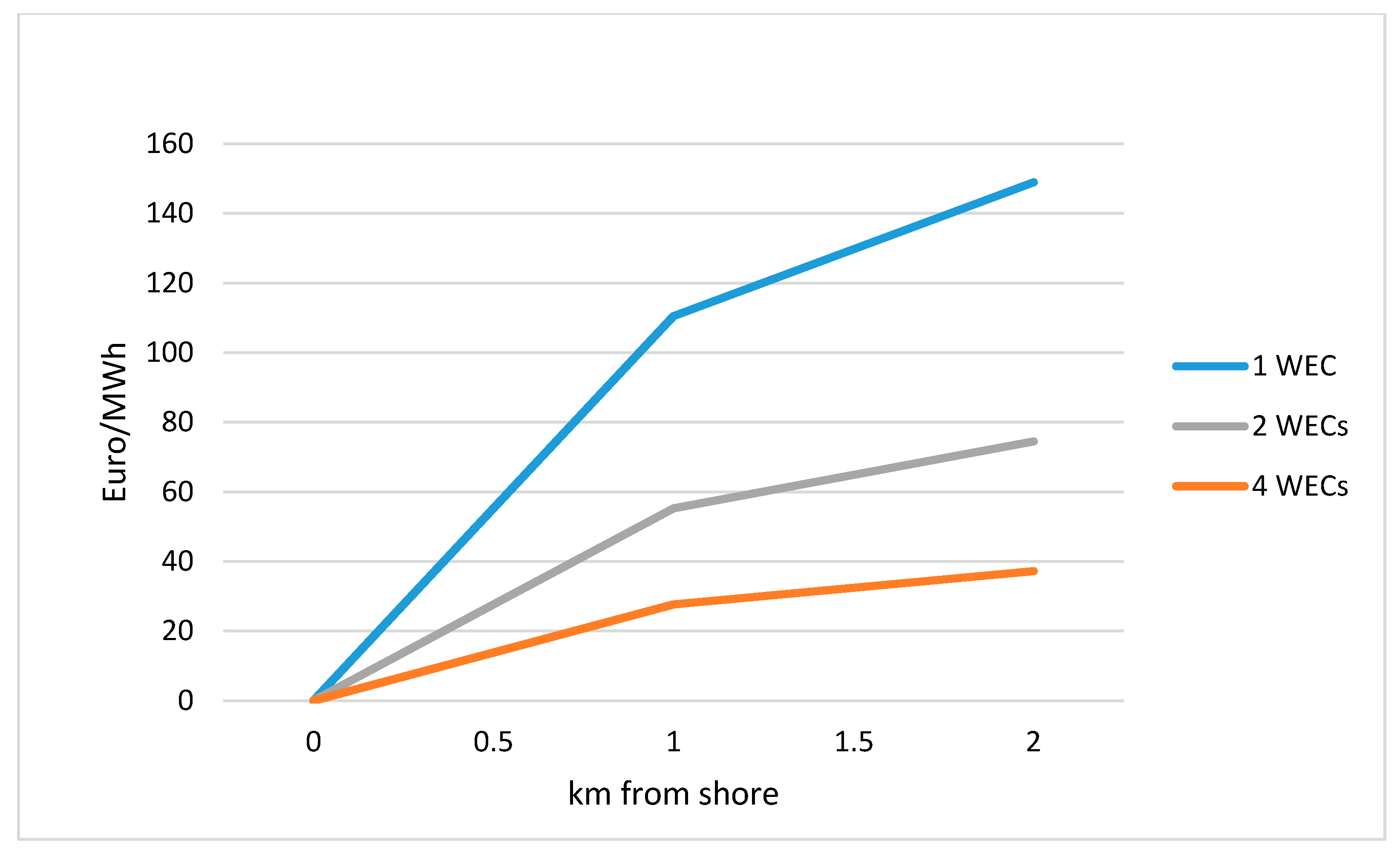
| Maldives | Bora Bora (French Polynesia) | Sports Hotel (Lanzarote, Spain) | |
|---|---|---|---|
| Application | Luxury resort | Small utility | Luxury resort |
| Average wave resource | 10–20 kW/m (a) | 20–30 kW/m (a) | 29 kW/m (b) |
| Current Cost of energy | 280–430 €/MWh (c) | 300 €/MWh (d) | 240 €/MWh (e) |
| Annual Demand | 4.38 GWh (f) | 42 GWh (d) | 8.76 GWh (g) |
| Bora Bora | Maldives | Maldives w/Battery Storage | Lanzarote | |
|---|---|---|---|---|
| Possible wave power | 1 MW | 0.3 MW | 0.5 MW | 0.5 MW |
| Number of WECs | 4 | 1 | 2 | 2 |
| Energy storage | - | - | 3000 kWh | - |
| Average capacity factor | 0.4 | 0.25 | 0.25 | 0.5 |
| Availability (a) | 90% | 90% | 90% | 90% |
| Annual energy production | 3154 MWh | 493 MWh | 986 MWh | 1971 MWh |
| Percent of total demand | 7.5% | 11.3% | 22.5% | 22.5% |
| Distance from shore | 200 m | 500 m | 500 m | 400 m |
| Bora Bora (M€) | Maldives (M€) | Maldives w/Battery Storage (M€) | Lanzarote (M€) | |
|---|---|---|---|---|
| Device CAPEX (a) | 2.56 | 0.64 | 1.28 | 1.28 |
| Moorings & anchor (a) | 0.52 | 0.13 | 0.26 | 0.26 |
| On-shore grid connection (fixed) | 0.5 | 0.5 | 0.5 | 0.5 |
| Cable cost (b) | 0.19 | 0.48 | 0.48 | 0.38 |
| Battery storage | 0.96 | |||
| Spare parts (2%) | 0.234 | 0.08 | 0.15 | 0.13 |
| Siting and permits (2%) | 0.234 | 0.08 | 0.15 | 0.13 |
| GHG investigations (0.05%) | 0.006 | 0.002 | 0.004 | 0.003 |
| Installation cost (15%) | 1.75 | 0.59 | 1.17 | 0.98 |
| Management cost (a) | 0.8 | 0.2 | 0.4 | 0.4 |
| Decommissioning (a) | 0.8 | 0.2 | 0.4 | 0.4 |
| O&M (8% of WEC CAPEX/year) (c) | 4.09 | 1.02 | 2.05 | 2.05 |
| Total project cost | 11.68 | 3.92 | 7.80 | 6.51 |
| Discount rate | 8% | 8% | 8% | 8% |
| Average capacity factor | 0.4 | 0.25 | 0.25 | 0.5 |
| LCOE (€/MWh) | 310 | 633 | 628 | 282 |
| Current Cost of energy (€/MWh) | 300 | 280 €–430 € | 240 | |
| Storage Capacity | 3000 kWh |
|---|---|
| Cost/kWh | 260 €/kWh (300 $/kWh) (a) |
| Initial cost | 780k € |
| Replacement cost | 180k € (b) |
| Tool | Found Factor | Viability Influence | Bora Bora | Maldives | Lanzarote |
|---|---|---|---|---|---|
| LCOE | Available wave resource | − Large available wave resource lowers the LCOE. | + | − | + |
| Distance from shore | − LCOE increases with distance from shore. | + | 0 | 0 | |
| Bathymetry | − LCOE increases with depth. | ||||
| Power demand and energy storage | − Power stability limits number of WECs. | − | − | + | |
| − Having more WECs decrease LCOE, due to gained economy of scale. | + | − | 0 | ||
| − Energy storage allows for more WECs. | + | ||||
| Supply chain logistics | − Challenges with supply chain logistics increase with distance from WEC developer. | − | − | 0 | |
| − Level of infrastructure is linked with supply chain Issues. | − | − | 0 | ||
| PESTEL | Proximity to society | − Public opposition increases with proximity. | − | − | + |
| Interfering with marine activities | − WECs share ocean space with other activities. | 0 | 0 | + | |
| Environmental impact assessment | − Varying and uncertain requirements for environmental assessment. | − | − | 0 | |
| Political stability | − Political stability influence commercialization process. | − | 0 | 0 | |
| Operational Licensing | − Uncertainties in obtaining operational licensing can cause delays or cancellations. | − | − | 0 | |
| Politics | − High RE goals increase wave energy viability. | + | + | 0 | |
| Porter’s Five Forces | Substitutes | − Threat-level from fossil fuel generators. | 0 | + | − |
| − Threat-level from other Res. | 0 | 0 | + | ||
| Rivals | − Smaller and lighter WECs can have competitive advantages in remote locations. | − | 0 | + |
© 2016 by the authors; licensee MDPI, Basel, Switzerland. This article is an open access article distributed under the terms and conditions of the Creative Commons Attribution (CC-BY) license (http://creativecommons.org/licenses/by/4.0/).
Share and Cite
Sandberg, A.B.; Klementsen, E.; Muller, G.; De Andres, A.; Maillet, J. Critical Factors Influencing Viability of Wave Energy Converters in Off-Grid Luxury Resorts and Small Utilities. Sustainability 2016, 8, 1274. https://doi.org/10.3390/su8121274
Sandberg AB, Klementsen E, Muller G, De Andres A, Maillet J. Critical Factors Influencing Viability of Wave Energy Converters in Off-Grid Luxury Resorts and Small Utilities. Sustainability. 2016; 8(12):1274. https://doi.org/10.3390/su8121274
Chicago/Turabian StyleSandberg, Aksel Botne, Eirik Klementsen, Gerrit Muller, Adrian De Andres, and Jéromine Maillet. 2016. "Critical Factors Influencing Viability of Wave Energy Converters in Off-Grid Luxury Resorts and Small Utilities" Sustainability 8, no. 12: 1274. https://doi.org/10.3390/su8121274






